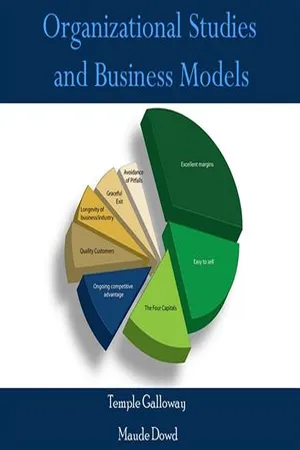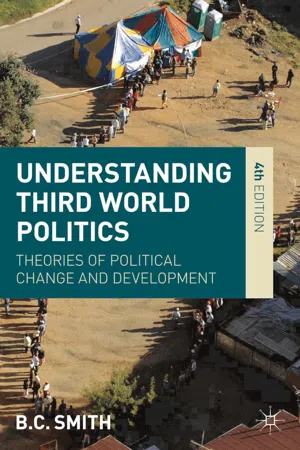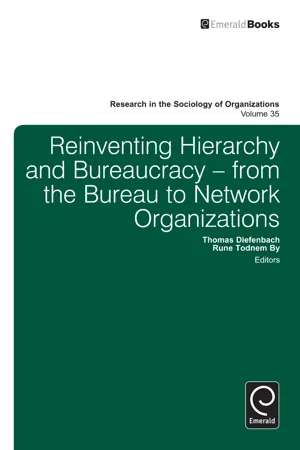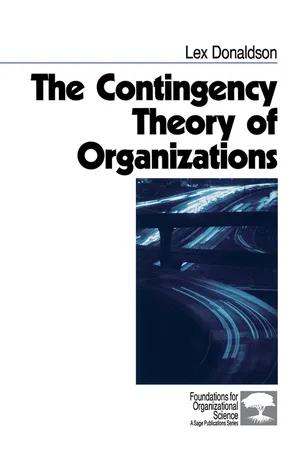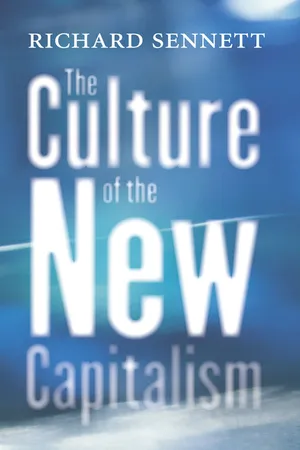Social Sciences
Bureaucracies
Bureaucracies are formal organizations characterized by hierarchical structures, standardized procedures, and specialized roles. They are designed to efficiently manage complex tasks and ensure consistency in decision-making. Bureaucracies are prevalent in government agencies, corporations, and other large institutions, and they play a crucial role in implementing policies, delivering services, and maintaining order in society.
Written by Perlego with AI-assistance
Related key terms
1 of 5
12 Key excerpts on "Bureaucracies"
- No longer available |Learn more
- (Author)
- 2014(Publication Date)
- College Publishing House(Publisher)
____________________ WORLD TECHNOLOGIES ____________________ Chapter- 2 Bureaucracy Bureaucracy is the combined organizational structure, procedures, protocols, and set of regulations in place to manage activity, usually in large organizations. As opposed to adhocracy, it is often represented by standardized procedure (rule-following) that guides the execution of most or all processes within the body; formal division of powers; hierarchy; and relationships, intended to anticipate needs and improve efficiency. A bureaucracy traditionally does not create policy but, rather, enacts it. Law, policy, and regulation normally originates from a leadership, which creates the bureaucracy to implement them. In practice, the interpretation and execution of policy, etc. can lead to informal influence - but not necessarily. A bureaucracy is directly responsible to the leadership that creates it, such as a government executive or board of directors. Conversely, the leadership is usually responsible to an electorate, shareholders, membership or whoever is intended to benefit. As a matter of practicality, the bureaucracy is where the individual will interface with an organization such as a government etc., rather than directly with its leadership. Generally, larger organizations result in a greater distancing of the individual from the leadership, which can be consequential or intentional by design. Definition Bureaucracy is a concept in sociology and political science referring to the way that the administrative execution and enforcement of legal rules are socially organized. Four structural concepts are central to any definition of bureaucracy: 1. a well-defined division of administrative labour among persons and offices, 2. a personnel system with consistent patterns of recruitment and stable linear careers, 3. a hierarchy among offices, such that the authority and status are differentially distributed among actors, and 4. - No longer available |Learn more
- (Author)
- 2014(Publication Date)
- Orange Apple(Publisher)
____________________ WORLD TECHNOLOGIES ____________________ Chapter- 6 Bureaucracy Bureaucracy is the combined organizational structure, procedures, protocols, and set of regulations in place to manage activity, usually in large organizations. As opposed to adhocracy, it is often represented by standardized procedure (rule-following) that guides the execution of most or all processes within the body; formal division of powers; hierarchy; and relationships, intended to anticipate needs and improve efficiency. A bureaucracy traditionally does not create policy but, rather, enacts it. Law, policy, and regulation normally originates from a leadership, which creates the bureaucracy to implement them. In practice, the interpretation and execution of policy, etc. can lead to informal influence - but not necessarily. A bureaucracy is directly responsible to the leadership that creates it, such as a government executive or board of directors. Conversely, the leadership is usually responsible to an electorate, shareholders, membership or whoever is intended to benefit. As a matter of practicality, the bureaucracy is where the individual will interface with an organization such as a government etc., rather than directly with its leadership. Generally, larger organizations result in a greater distancing of the individual from the leadership, which can be consequential or intentional by design. Definition Bureaucracy is a concept in sociology and political science referring to the way that the administrative execution and enforcement of legal rules are socially organized. Four structural concepts are central to any definition of bureaucracy: 1. a well-defined division of administrative labour among persons and offices, 2. a personnel system with consistent patterns of recruitment and stable linear careers, 3. a hierarchy among offices, such that the authority and status are differentially distributed among actors, and 4. - No longer available |Learn more
- (Author)
- 2014(Publication Date)
- Orange Apple(Publisher)
WT ____________________ WORLD TECHNOLOGIES ____________________ Chapter- 2 Bureaucracy Bureaucracy is the combined organizational structure, procedures, protocols, and set of regulations in place to manage activity, usually in large organizations. As opposed to adhocracy, it is often represented by standardized procedure (rule-following) that guides the execution of most or all processes within the body; formal division of powers; hierarchy; and relationships, intended to anticipate needs and improve efficiency. A bureaucracy traditionally does not create policy but, rather, enacts it. Law, policy, and regulation normally originates from a leadership, which creates the bureaucracy to implement them. In practice, the interpretation and execution of policy, etc. can lead to informal influence - but not necessarily. A bureaucracy is directly responsible to the leadership that creates it, such as a government executive or board of directors. Conversely, the leadership is usually responsible to an electorate, shareholders, membership or whoever is intended to benefit. As a matter of practicality, the bureaucracy is where the individual will interface with an organization such as a government etc., rather than directly with its leadership. Generally, larger organizations result in a greater distancing of the individual from the leadership, which can be consequential or intentional by design. Definition Bureaucracy is a concept in sociology and political science referring to the way that the administrative execution and enforcement of legal rules are socially organized. Four structural concepts are central to any definition of bureaucracy: 1. a well-defined division of administrative labour among persons and offices, 2. a personnel system with consistent patterns of recruitment and stable linear careers, 3. a hierarchy among offices, such that the authority and status are differentially distributed among actors, and 4. - eBook - PDF
Understanding Third World Politics
Theories of Political Change and Development
- Brian Smith(Author)
- 2013(Publication Date)
- Red Globe Press(Publisher)
‘Bureaucracy’ can simply refer to a government’s administrative agen-cies staffed by public servants. It is synonymous with public administration, 126 consisting of organizations set up as part of the modern state to carry out the policies of decision-makers. The state needs specialized institutions for implementing public policy and employs large numbers of people who make it their career to serve the state in a professional capacity. The bureaucracy thus refers to the public services and the organizations into which they are structured. It is a category of governmental personnel and offices that are filled in a particular way. It tells us no more about the way those organizations function, or about the political power that the bureau-cracy might exercise – either over the formulation of public policies, or their mode, and even degree of implementation. Part of the importance of public Bureaucracies in developing countries arises from the demands that have been made on governments to stimu-late development by providing a social and economic infrastructure, and engaging directly in production. After independence, state Bureaucracies were seen as promoters of social and economic change through planned development programmes (Jain, 1992). Even when the ideology has been predominantly capitalist and free-market, the state has intervened to support private capital. In the newly industrialized countries (NICs) of Southeast Asia and Latin America, the state and the bureaucracy have been highly interventionist. In the Philippines, the civil service continues to expand, despite efforts to trim the bureaucracy. A combination of pres-idential patronage and a wide range of policy objectives – in health, education, housing, security, environment, law and order, and support to economic sectors – is responsible. - eBook - PDF
Organizations
Management Without Control
- Howard P. Greenwald(Author)
- 2007(Publication Date)
- SAGE Publications, Inc(Publisher)
Team positions in a recreational football Bureaucracy —— 343 league reflect specific tasks and expectations, but the players are in no way bureaucrats. All organizations are rationalized to some extent, coalescing around recognizable objectives and deliberately allocating human and material resources in their pursuit. Bureaucracy, though, represents an extreme. It is the most highly rationalized and formalized of organizations. Bureaucracy defines the activities required of and permitted to members in an unusually minute fashion. The formalization characteristic of bureaucracy requires a high degree of role specificity. This can be observed in the numerous and detailed job descriptions that characterize bureau-cracies. Universalism, affective neutrality, and achievement orientation contribute to the bureaucracy’s ability to allocate resources in a technically objective manner— a hallmark of rationalization. A Definition of Bureaucracy Bureaucracy defies a simple definition. Organizations of this kind have existed for thousands of years and in many countries. Bureaucracies assume different qual-ities under the influence of the social forces and cultures that surround them, but a core definition of bureaucracy applicable everywhere can be specified. This defini-tion conjures up the routinized, regimented, and emotionally cold colossi familiar across national boundaries and generations: Bureaucracies are organizations char-acterized by rules binding on the actions of all members; hierarchical supervision; specialization by personnel; prohibition of personal gain other than fixed salaries; and continuous operation over time. Operating Characteristics Modern management science owes much of its understanding of bureaucracy to a German thinker of the early 20th century named Max Weber. A scholar of tremendous depth, Weber made a study of organizational structures throughout the history of the civilized world. - eBook - ePub
- Carl J. Couch, Mark D. Johns(Authors)
- 2017(Publication Date)
- Routledge(Publisher)
The bureaucratic paradigm implicitly denies that human action is willful and emergent. But social structures are created and maintained by people acting with intentionality and even the most rigid social structures constantly evolve and devolve. The establishment of a bureaucracy clearly is a willful act. As bureaucratic structures mature, the social objectives that informed their creation often recede and are supplanted by willful acts undertaken to promote personal advancement. However, the actions that maintain bureaucratic structures also are willful. All social action is given structure by persons projecting futures and organizing themselves to bring a projected future to fruition. The actions of no one, not even those of the most bureaucratized person, merely reflect norms and values.All bureaucrats recognize that not all action can proceed according to established formats. Yet the continuation of each bureaucratic structure is partially contingent on general acceptance of that belief. One irony is the belief among many social scientists that the paradigm of thought implied by bureaucratic structures is adequate for the analysis of social life. Only the most naive bureaucrats think that formal procedures are adequate for all situations; experienced bureaucrats know human action does not confine itself to bureaucratic formats. It would seem that specialists in the study of social structures would be as sophisticated about social structures as bureaucrats.Bureaucratic structures are one procedure for the management of large bodies of quantitative information. But bureaucratic structures are not the only procedure for processing information about communal welfare, and they certainly are not the ultimate social form. Instead of conceptualizing them as the epitome of rationality, as functionalists do, one might conceptualize them as an aberrant social form. A question that seems worthy of attention is: How can large bodies of information be managed without the creation of a set of social relationships that generates the sentiments and interests peculiar to Bureaucracies?ConclusionsBureaucratic structures have evolved from their first appearance five to six thousand years ago to being a significant dimension of nearly all complex organizations. Much of the evolution of Bureaucracies has been driven by a concern on the part of bureaucrats for greater efficiency, for example, the development of new surfaces on which to record information by the ancient Egyptians and the computerization of modern Bureaucracies. Papyrus allowed the Egyptian bureaucrats to be more efficient than their Sumerian counterparts, who recorded on clay. Computers make modern bureaucrats more efficient than those of the royal French state, who recorded information with quills on paper. - eBook - PDF
Building the Virtual State
Information Technology and Institutional Change
- Jane E. Fountain(Author)
- 2004(Publication Date)
- Brookings Institution Press(Publisher)
CHAPTER FOUR Bureaucracy The reduction of modern office management to rules is deeply embedded in its very nature. Max Weber, Economy and Society INGE THE INDUSTRIALIZATION of the United States in the late nineteenth century, government has required a complex administrative and policymaking machinery in order to manage its day-to-day operations and implement legislation. The rhetoric of 'J3ost-bureaucracy notwithstanding, this administrative machinery, and the career public servants within it, continues to be an essential intermediary between elected officials and society. It transforms the often vague and ambiguous decisions and judgments of the executive, the legislature, and the judiciary into operational and organizational rules and programs. Its attributes and vitality are more than ever of crucial concern to govern-ment and, ultimately, to citizens. In an industrialized society and economy, the state is central to contemporary political life. 1 This chapter develops ideas first published in 'The Virtual State: Toward a Theory of Federal Bureaucracy in the Twenty-First Century,in Elaine Ciulla Kamarck and Joseph S. Nye Jr., eds., democracy.com? Governance in a Networked World (Hollis, N.H.: Hollis, 1999). I am grateful to the Visions of Governance in the Twenty-First Century Project at the Kennedy School of Government, Harvard University, for finan-cial support and to the faculty associated with that project for early comments on many of the points discussed in this chapter. 44 S BUREAUCRACY 45 It is commonplace to claim that information technology changes the structure of organizations. Attention to network organizations signals one significant move away from bureaucracy. The reduction of red tape and flattening of hierarchies in government over the past decade have signaled further change. Yet few researchers interested in technology have addressed the bureaucratic structure, or the modern state, in much detail. - eBook - PDF
Men as Managers, Managers as Men
Critical Perspectives on Men, Masculinities and Managements
- David Collinson, Jeff Hearn, David Collinson, Jeff Hearn(Authors)
- 1996(Publication Date)
- SAGE Publications Ltd(Publisher)
Of possible rele-vance here is Collins's argument that those who are more likely to be found giving orders are also more likely to develop a degree of identif icat ion with the organization for which they work (Collins, 1991). Further, since an emphasis in the following discussion will be upon tensions, ambiguities and contradictions within Bureaucracies these sources of variation will also have their impact upon the constructions of men and masculinities. Some reference, however brief, to the point of departure is essential. Weber's discussion of bureaucracy was part of a wider analysis of the rational character of modern Western society and this, in its turn, was part of a wider exploration of the dif ferent bases of legitimate authority and the social systems upon which these were based. Bureaucracy is seen therefore as not simply a type of organization that is common, increasingly so, within Western society, but as a reflection of the very principles upon which a modern society is based. In order to explore the nature of bureaucracy The Gender of Bureaucracy 45 and its wider significance, Weber draws up an ideal type, a heightened and exaggerated model of some of its key and interrelated features. Having established such a model, it becomes possible to explore actual organiz-ations and the extent to whic h they might depart from this ideal typification. Key features of bureaucracy in this model include a clear ly established division of labour, the setting up of 'offices ' based upon established rules and codes of practice, clearly defined lines of authority and hierarchy, impersonality and the deployment of technical expertise. A common feature in subsequent discussions of bureaucracy was the contrast between this model and more commonsense, pejorative usages of the term 'bureaucracy '. Popular understandings of bureaucracy are almost entirely negative, focusing on red tape and inefficiency. - eBook - PDF
Reinventing Hierarchy and Bureaucracy
From the Bureau to Network Organizations
- Thomas Diefenbach, Rune Todnem By, Thomas Diefenbach, Rune Todnem By(Authors)
- 2012(Publication Date)
- Emerald Group Publishing Limited(Publisher)
In doing this, we follow a line of reasoning recently presented by Olsen (2008) who argues that the idea of bureaucracy, both as outlined by Max Weber and in the way it has been institutionalized in democratic states, combines three principles of governance: hierarchy, rules and expertise. Since governments and parliaments have legislative supremacy and authority, there has to be a hierarchical system in place – a bureaucracy – in order to ensure that the will of parliament is implemented and officers of state and government are held accountable for their decisions and actions. Democratic–bureaucratic authority is embedded in constitutions and has to be rule-bound, not least because it regulates the relationships between citizens and representatives, as well between politicians and administrators, law and administration and within the bureaucracy itself. Furthermore, bureaucracy is expert authority since civil servants are selected on the basis of their professional, impartial and non-partisan knowledge. It follows from this that bureaucracy is not just an instrument, but also an institution ‘with a raison d’eˆ tre of its own’, the bureaucracy is ‘a changing mix of fairly enduring and legitimate organizational forms’ that has developed differently in different states and political contexts ( Olsen, 2008 ). Recently, there has been a call for a return to bureaucracy, both as a response to some of the accountability problems associated with the fragmenting forces of NPM, as well as the crises and scandals, such as those HALDOR BYRKJEFLOT AND PAUL DU GAY 94 associated with the ongoing credit crisis, which have also triggered demands for legal rules and an ethos of responsibility. The World Bank, among others, has given increased attention to the relationship between good government, economic development, reduced corruption and poverty. - eBook - ePub
- Lex Donaldson(Author)
- 2001(Publication Date)
- SAGE Publications, Inc(Publisher)
Throughout much of this discussion size will be the main contingency, with task (i.e., task interdependence) a minor contingency. We will then discuss whether certain other causes of organizational structure are contingencies or not, in the process defining the criterion for a cause to be a contingency. Finally, we will attend to the issue of synthesizing the bureaucracy with the organic theory, in a way that follows on from, but goes farther than, the brief synthesis offered at the end of Chapter 1. Bureaucracy Theory Bureaucracy theory (Blau, 1970, 1972; Child 1973a) in its modern form emerged from a series of empirical studies. However, from the outset of modern research, thinking about bureaucracy was strongly influenced by the Weberian model of bureaucratic organizational structure, which omitted the idea of participation that is so central to organic theory. Weber (1968) held that there was a general, historical tendency for administration to move toward the bureaucratic type. The bureaucratic structure features full-time, salaried, career administrators who are appointed on merit, technically qualified, arranged in a hierarchy, and subject to rules and discipline (Weber 1964, pp. 333-334). Bureaucracy possessed several advantages including efficiency, predictability, reliability, and the “stringency of its discipline” (Weber 1964, p. 337). The development of bureaucratic structure is promoted by a number of factors, including size and communications technologies (Weber 1964, pp. 338-339). Bureaucratic theory led to a number of empirical studies that used qualitative methods to make case studies of organizations (Crozier 1964; Gouldner 1954; Selznick 1949) - eBook - PDF
- Hendrik Hegemann(Author)
- 2015(Publication Date)
- Nomos/Bloomsbury(Publisher)
They do not only perform tasks delegated to them by states, but also exercise independent power by constructing and dispersing norms, standards, and classifications. Hence, international Bureaucracies have influence “not so much because they possess material and informational resources but, more fundamentally, be-cause they use their authority to orient action and create social reality” (Bar-nett and Finnemore 2004, 6). Proponents of this approach go on to argue that international Bureaucracies ironically exercise political power “precisely by creating the appearance of depoliticization” (Barnett and Finnemore 1999, 708). Bureaucracies develop a specific understanding of their job, their envi-ronment, and their role in the world that is shaped by their mandates, profes-sional background, and routines. Thus, bureaucratic action is oriented to-wards a distinct and deeply institutionalized organizational culture (Barnett and Finnemore 2004, 18-20). Since the environment of international bureau-cracies is cultural as well, their role is also influenced by external-cultural factors. The world polity model maintains that international Bureaucracies seek legitimacy from their environment and orient their action towards preva-lent principles and identities prescribed to them by world society (Boli and Thomas 1997). 8 Barnett and Finnemore (2004, 2) themselves call their work “constructivist”, but they draw heavily on sociological institutionalism (Finnemore 1996b). 48 from states interact with internal bureaucratic cultures and politics (Nielson et al. 2006; Weaver and Leiteritz 2005). Table 1: Theoretical Approaches to International Bureaucracies Internal External Material Bureaucratic Politics Principal-Agent Theory Cultural Bureaucratic Culture World Polity Source: Author (adapted from Barnett and Finnemore 1999, 716; 2004, 36, 42 ). - eBook - PDF
- Richard Sennett(Author)
- 2008(Publication Date)
- Yale University Press(Publisher)
The welfare state also assumed the form of a bu-reaucratic pyramid. In social-democratic principle, wel-fare benefits, like old-age pensions and education, were conceived as universal rights; in practice, even Nordic and British welfare systems obliged their clients to think like bureaucrats in dealing with their own needs. The bureaucratic rules served the bureaucracy first and foremost; elderly, students, the unemployed, and the sick were obliged to behave like officeholders in the Weberian sense rather than as individuals with distinc-tive life histories. The system focused ever more on in-stitutional self-maintenance and stability rather than on the effective delivery of care. It cannot surprise the sociologist, in a way, that the first half of the twentieth century was devoted to war, for the organization of armies had become the very model for civil society. Yet the “militarization of soci-ety” carries false implications, were we to imagine that it produced a mass of blind, subservient, obedient work-ers or welfare clients. Had Weber more actual experi-ence of military life he would have understood why. B U R E A U C R A C Y . 33 . In an army, orders modulate as they pass down a chain of command: what the general decrees, the mil-itary staff begins to translate into practice, adapting the command to conditions in the field; sergeants, cor-porals, and rank privates try in their turn to make sense of the command on a particular patch of ground. All obey, but equally, all interpret. When an order trans-lates into action, the key word is “translates.” The larger the army, the more interpretation is required. The same mediation marks domestic pyramids and is one reason the apostles of efficiency like Taylor failed. His time-and-motion studies produced some-thing like a field marshall’s writ about what things should happen and how they were to be done. In prac-tice, each of these precepts was interpreted and negoti-ated as it passed down the institutional structure.
Index pages curate the most relevant extracts from our library of academic textbooks. They’ve been created using an in-house natural language model (NLM), each adding context and meaning to key research topics.
